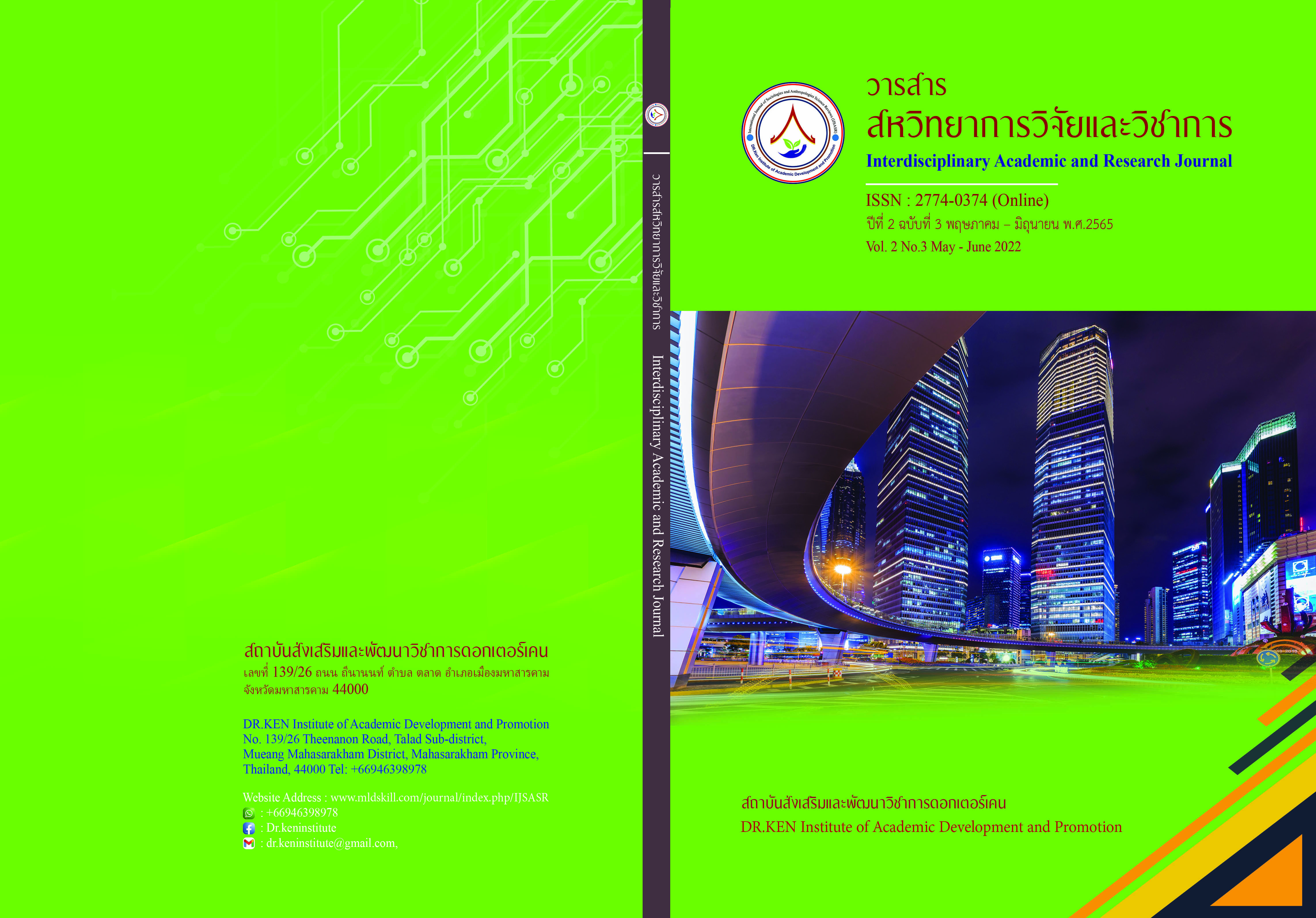Rajabhat Village According to the Kings Philosophy for Developing the Sustainable: Prosperity Distribution and Livable Town for Economy, Social and Environmental Development: Phase I
DOI:
https://doi.org/10.14456/iarj.2022.27Keywords:
Rajabhat Village; , The King's Science; , Sustainable Development; , Vibrant CitiesAbstract
This research project is research and development under the concept of participatory action research. The objectives are to develop a social drive that is rich in democratic wisdom, develop quality and safe agricultural products, develop a sustainable community environmental management model, develop a sustainable community economy, develop a government management system and mechanism, and create a model of health care for people with herbs. The research area is Kaeng Loeng Chan Subdistrict, Mueang District, Maha Sarakham Province. The target population is sub-district administrative organization administrators, sub-district and village administrative groups, local government officials, farmers' groups, and general people. Data collection tools include questionnaires, semi-structured interviews, group discussions, brainstorming sessions, and participant workshops. Quantitative data analysis uses basic statistics to analyze data. The qualitative data used the content analysis method and thematic analysis and then presented the descriptive results of the research. The results found that (1) The development of social drives that are rich in community democratic wisdom found that resulting in a conceptual framework that creates a democratic intellectual society, namely the way of the individual, the way of the people, and the social mechanism. (2) Development of quality and safe agricultural products to develop into sustainable agriculture of the community found that should create or develop a safe vegetable production model for such communities to be a learning center and a source for producing safe vegetables from chemicals for consumption and distribution to the community. (3) The development of a sustainable community environmental management model found that the environmental problem in the community is the problem of solid waste management in the community. As a result of such problems, there are many impacts on the environment in the community. (4) Sustainable development of community economy based on natural resources and local wisdom based on sufficiency economy. Community members come together to formulate solutions to their own problems and needs in order to create a community economic development plan and action plan using AIC techniques. (5) Development of government management systems and mechanisms to support the development of model communities on the basis of morality and transparency. Distinctive features of Kaeng Loeng Chan Subdistrict Administrative Organization administration, executives have high leadership, emphasizing participatory management in solving problems, emphasizing unity in the work of personnel in the organization. And (6) The creation of a model of health care for people with folk herbs found that (A) The government sector needs to create a clear network between the government and community to promote the use of herbs in health care. (B) In the community sector in order to obtain guidelines for organizing activities in community health care, it was found that the target group used herbs for health care in general, using herbs for health care at some times with an average score. is equal to 2.27(S.D.=0.52).
References
กิ่งแก้ว สุวรรณคีรี นพพร จันทรนำชู และนรินทร์ สังข์รักษา (2559). รูปแบบการสร้างเสริมพลังอำนาจชุมชนเพื่อการจัดทำแผนชุมชน. Veridian E-Journal, Silpakorn University, 9 (2), 1787-1801.
โกวิทย์ พวงงาม (2545).ความรู้ ทัศนคติ และการปฏิบัติของประชาชนในการมีส่วนร่วมต่อการบริหารงานแบบกระจายอำนาจ. กรุงเทพฯ: สำนักงานเลขาธิการสภาผู้แทนราษฎร.
เจน จันทรสุภาเสน และคณะ (2563). การใช้เทคนิค AIC เพื่อการเฝ้าระวังและการมีส่วนร่วมของชุมชน ในการอนุรักษ์แมงกะพรุนน้ำจืด ในพื้นที่ตำบลหนองแม่นา อำเภอเขาค้อ จังหวัดเพชรบูรณ์. วารสารรัชต์ภาคย์, 14 (37), 204-214.
ดุษฎี พรหมทต (2558). พฤติกรรมการผลิตผักปลอดภัยของเกษตรกร จังหวัดพระนครศรีอยุธยา. วารสารวิจัยสหวิทยาการไทย, 10 (3),8-16.
ตรียากานต์ พรมคำ (2563). การศึกษาสภาพปัญหาการจัดการขยะมูลฝอยในเขตเทศบาลเมืองเพชรบูรณ์ จังหวัดเพชรบูรณ์. วารสารชุมชนวิจัย, 14 (4), 52-62.
ประมุข ศรีชัยวงศ์ อินทุราภรณ์ อินทรประจบ, สมศักดิ์ จั่นผ่อง, ธรรมรัตน์ โพธิสุวรรณปัญญา และ ชูเกียรติ ผลาผล (2564). พฤติกรรมการผลิตผักปลอดภัยของเกษตรกร ตำบลนาเสียว อำเภอเมือง จังหวัดชัยภูมิ. Journal of Modern Learning Development, 6 (6), 296-307.
รินทิพย์ ศรีสว่างวงศ์ และ ปิยะนุช เงินคล้าย (2564). ความร่วมมือระหว่างภาครัฐและเอกชนในการขับเคลื่อนนโยบายขนส่งสาธารณะ ในจังหวัดสุราษฎร์ธานี. วารสารการวิจัยการบริหารการพัฒนา, 11 (1),150-164.
สัญญา เคณาภูมิ (2563). “สังคมอุดมปัญญาประชาธิปไตย” (Democratic Intelligence Society), รัฐสภาสาร, 68 (1),36-83.
สำนักงานคณะกรรมการกองทุนหมู่บ้านและชุมชนเมืองแห่งชาติ, สำนักงานสภาสถาบันราชภัฎและทบวงมหาวิทยาลัย (2546). รายงานการสังเคราะห์สารนิพนธ์บัณฑิตกองทุน หลักสูตรประกาศนียบัตรบัณฑิต สาขาการจัดการและการประเมินโครงการ. กรุงเทพฯ : สำนักงานคณะกรรมการกองทุนหมู่บ้านและชุมชนเมืองแห่งชาติ : สำนักงานสภาสถาบันราชภัฏ กระทรวงศึกษาธิการ : ทบวงมหาวิทยาลัย,
สำนักมาตรฐานการศึกษาสำนักงานสภาสถาบันราชภัฎกระทรวง ศึกษาธิการสำนักมาตรฐานอุดมศึกษาและทบวงมหาวิทยาลัย (2545). ชุดวิชาการวิจัยชุมชน. นนทบุรี: เอส.อาร์. พริ้นติ้ง แมสโปรดักส.
อัจฉรา สุมังเกษตร และ ชัยวัฒน์ นันทศร (2559). องค์ความรู้ภูมิปัญญาของหมอยาพื้นบ้าน กรณีศึกษา อำเภอนามน จังหวัดกาฬสินธุ์. TLA Research J, 9 (2), 87-104.
Downloads
Published
How to Cite
Issue
Section
License
Copyright (c) 2022 Suthinee Atthakorn, Sanya Kenaphoom, Sumran Pimratch, Thanyachanok Pawala, Warit Rasri, Rutchanun Srisupak, Subunn Ieamvijarn, Jaruwan Aeksapang, Pornpisanu Thammapat, Prapakorn Srisawangwong

This work is licensed under a Creative Commons Attribution-NonCommercial-NoDerivatives 4.0 International License.
Copyright on any article in the Interdisciplinary Academic and Research Journal is retained by the author(s) under the under the Creative Commons Attribution-NonCommercial-NoDerivatives 4.0 International License. Permission to use text, content, images, etc. of publication. Any user to read, download, copy, distribute, print, search, or link to the full texts of articles, crawl them for indexing, pass them as data to software, or use them for any other lawful purpose. But do not use it for commercial use or with the intent to benefit any business.
















.png)


